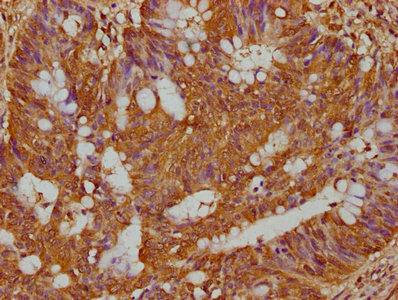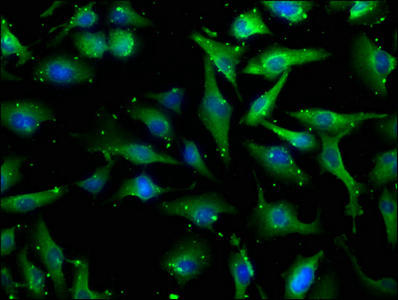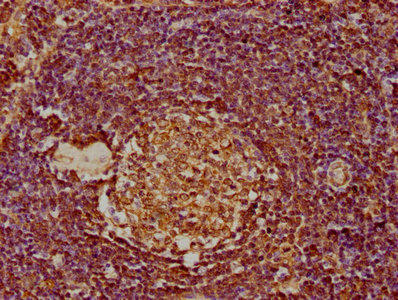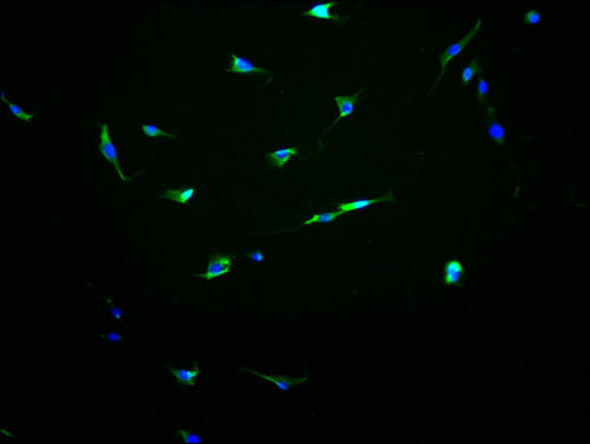Description
| Antibody Name: | MDFIC Antibody (PACO62631) |
| Antibody SKU: | PACO62631 |
| Size: | 50ul |
| Host Species: | Rabbit |
| Tested Applications: | ELISA, IHC, IF |
| Recommended Dilutions: | ELISA:1:2000-1:10000, IHC:1:200-1:500, IF:1:50-1:200 |
| Species Reactivity: | Human |
| Immunogen: | Peptide sequence from Human MyoD family inhibitor domain-containing protein (35-53AA) |
| Form: | Liquid |
| Storage Buffer: | Preservative: 0.03% Proclin 300 Constituents: 50% Glycerol, 0.01M PBS, pH 7.4 |
| Purification Method: | >95%, Protein G purified |
| Clonality: | Polyclonal |
| Isotype: | IgG |
| Conjugate: | Non-conjugated |
 | IHC image of PACO62631 diluted at 1:300 and staining in paraffin-embedded human colon cancer performed on a Leica BondTM system. After dewaxing and hydration, antigen retrieval was mediated by high pressure in a citrate buffer (pH 6.0). Section was blocked with 10% normal goat serum 30min at RT. Then primary antibody (1% BSA) was incubated at 4°C overnight. The primary is detected by a biotinylated secondary antibody and visualized using an HRP conjugated SP system. |
 | Immunofluorescence staining of U251 cells with PACO62631 at 1:100, counter-stained with DAPI. The cells were fixed in 4% formaldehyde, permeabilized using 0.2% Triton X-100 and blocked in 10% normal Goat Serum. The cells were then incubated with the antibody overnight at 4°C. The secondary antibody was Alexa Fluor 488-congugated AffiniPure Goat Anti-Rabbit IgG(H+L). |
 | IHC image of PACO62631 diluted at 1:300 and staining in paraffin-embedded human lymph node tissue performed on a Leica BondTM system. After dewaxing and hydration, antigen retrieval was mediated by high pressure in a citrate buffer (pH 6.0). Section was blocked with 10% normal goat serum 30min at RT. Then primary antibody (1% BSA) was incubated at 4°C overnight. The primary is detected by a biotinylated secondary antibody and visualized using an HRP conjugated SP system. |
| Background: | Acts as a transcriptional activator or repressor. Inhibits the transcriptional activation of Zic family proteins ZIC1, ZIC2 and ZIC3. Retains nuclear Zic proteins ZIC1, ZIC2 and ZIC3 in the cytoplasm. Modulates the expression from both cellular and viral promoters. Down-regulates Tat-dependent transcription of the human immunodeficiency virus type 1 (HIV-1) LTR by interacting with HIV-1 Tat and Rev and impairing their nuclear import, probably by rendering the NLS domains inaccessible to importin-beta. Also stimulates activation of human T-cell leukemia virus type I (HTLV-I) LTR. Binds to the axin complex, resulting in an increase in the level of free beta-catenin. Affects axin regulation of the WNT and JNK signaling pathways. |
| Synonyms: | MyoD family inhibitor domain-containing protein (I-mfa domain-containing protein) (hIC), MDFIC |
| UniProt Protein Function: | MDFIC: Acts as a transcriptional activator or repressor. Inhibits the transcriptional activation of Zic family proteins ZIC1, ZIC2 and ZIC3. Retains nuclear Zic proteins ZIC1, ZIC2 and ZIC3 in the cytoplasm. Modulates the expression from both cellular and viral promoters. Down-regulates Tat-dependent transcription of the human immunodeficiency virus type 1 (HIV-1) LTR by interacting with HIV-1 Tat and Rev and impairing their nuclear import, probably by rendering the NLS domains inaccessible to importin- beta. Also stimulates activation of human T-cell leukemia virus type I (HTLV-I) LTR. Binds to the axin complex, resulting in an increase in the level of free beta-catenin. Affects axin regulation of the WNT and JNK signaling pathways. Belongs to the MDFI family. 2 isoforms of the human protein are produced by alternative initiation.Protein type: NucleolusChromosomal Location of Human Ortholog: 7q31.1-q31.2Cellular Component: Golgi apparatus; nucleoplasmMolecular Function: cyclin binding; protein binding; Tat protein binding; transcription factor bindingBiological Process: activation of JNK activity; negative regulation of protein import into nucleus; negative regulation of transcription, DNA-dependent; positive regulation of transcription, DNA-dependent; positive regulation of viral transcription; regulation of Wnt receptor signaling pathway |
| UniProt Protein Details: | |
| NCBI Summary: | This gene product is a member of a family of proteins characterized by a specific cysteine-rich C-terminal domain, which is involved in transcriptional regulation of viral genome expression. Alternative translation initiation from an upstream non-AUG (GUG), and an in-frame, downstream AUG codon, results in the production of two isoforms, p40 and p32, respectively, which have different subcellular localization; p32 is mainly found in the cytoplasm, whereas p40 is targeted to the nucleolus. Both isoforms have transcriptional regulatory activity that is attributable to the cysteine-rich C-terminal domain. Alternative splicing results in multiple transcript variants. [provided by RefSeq, Oct 2009] |
| UniProt Code: | Q9P1T7 |
| NCBI GenInfo Identifier: | 257051035 |
| NCBI Gene ID: | 29969 |
| NCBI Accession: | Q9P1T7.2 |
| UniProt Secondary Accession: | Q9P1T7,Q9P1T6 |
| UniProt Related Accession: | Q9P1T7 |
| Molecular Weight: | 37,042 Da |
| NCBI Full Name: | MyoD family inhibitor domain-containing protein |
| NCBI Synonym Full Names: | MyoD family inhibitor domain containing |
| NCBI Official Symbol: | MDFIC |
| NCBI Official Synonym Symbols: | HIC |
| NCBI Protein Information: | myoD family inhibitor domain-containing protein |
| UniProt Protein Name: | MyoD family inhibitor domain-containing protein |
| UniProt Synonym Protein Names: | I-mfa domain-containing protein; hIC |
| Protein Family: | |
| UniProt Gene Name: | MDFIC |
| UniProt Entry Name: | MDFIC_HUMAN |






